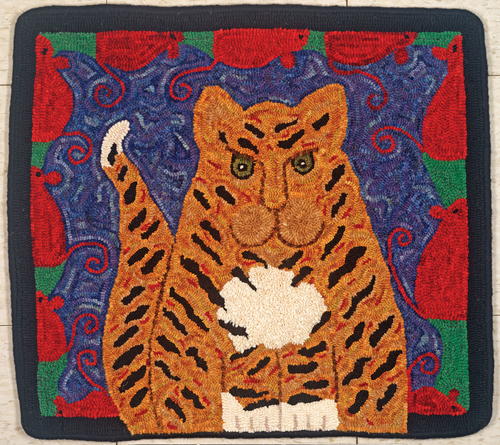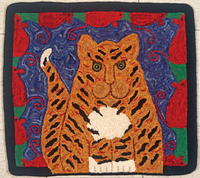Calico Cat
A Rug Hooking Exclusive Pattern: Calico Cat pattern and instructions

Calico Cat, 23" x 21", #3- and #5-cut wool on linen. Designed and hooked by Nancy Jewett of Fluff & Peachy Bean Designs, Salisbury, Vermont, 2010.
This design is loosely based on my dad's calico cat, the beautiful, well-fed, pampered, mischievous, and entertaining queen of the house. I think we've all known a cat such as Calico Cat! This pattern captures her fun-loving personality in the crook of her tail and her mischievous expression as the mice wave their tails teasingly. This is a pattern to have fun with in color choice and hooking techniques.
Enlarge and Transfer the Pattern
To enlarge the pattern you can use 1" grid paper or take the pattern insert to your local printer to have it enlarged to 23" x 21".
Prepare your backing by serging or zigzagging around the edges to prevent fraying. Your backing should measure 31" x 29", which will give you a 4" margin. You can use either a light table, Red Dot, or a large window to transfer the pattern. Make sure to use a fresh marker when you draw the lines on the backing so you get clear, sharp lines to hook by.
Hook the Pattern
Calico Cat
Outline the cat in the lightest or brightest of your wool, which will help to make the cat stand out against the background. I used three spot dyes over various wools. If you are doing the tail tip and paws in another color, such as natural, outline this area in the same color as for the other natural colored areas. The natural wool of her belly, paws, and tail tip is also a spot dye that uses the same dyes as the cat wool in very small amounts.
I chose to emphasize the belly of this well-fed kitty by hooking her tummy in natural wool and leaving the loops very high. Originally I was going to sculpt the belly to emphasize the roundness, so I had hooked each subsequent row a little higher. But after I finished hooking the belly and cut the loops, I decided to leave it as is until I had finished hooking the entire cat. In the end, I decided to keep the furry/fuzzy look as it was. You can have fun with this section by using roving or some fuzzy yarns.
To hook the face, outline the mouth, nose, and the eye with the darkest of your cat wool. For the eye, use a strip of #3-cut natural and pull up two ends about 1/2" high to form the light in the cat's eye. Twist the ends together and leave them alone for now. With a #3-cut black strip, hook around the two natural ends very closely and tightly. Using the pupil color, hook the rest of the eye. Now snip off the ends of the natural wool so they're even with the other loops. Hook the nose and the cheeks of your cat to finish the face. I hooked the nose from bottom to top and the cheeks in a circle.
Next, hook the calico spots in black; then, with your cat colors, hook around these spots. I mixed the cat wools together and hooked randomly. I periodically hooked three to five loops of the mouse red in my cat to add an extra spark. If you are using a different color wool for the paws, hook that before you hook the spots. Hook the cat's tail, doing the calico spots first, then hook around them as you did on the rest of the cat. Be sure to occasionally mix in three to five loops of the mouse red.
Mice and Grass
Begin hooking at the tip of the tail, hooking right down the mouse's haunches, then continue outlining the rest of the body. This sequencing gives a nice continuation of the tail meeting the body. I changed the eyes from mouse to mouse, hooking two ends in some, or one end and one loop, or one end and two loops, using black wool. Fill in the rest of the body. I used two hues of red, mixing them together randomly in each mouse. Outline, then fill in the grass between the mice. You could hook this area higher and cut the loops for additional grassy texture.
Background
For the background I used five spot dyes over various textures in three different strengths of the same dye recipe. To hook, first outline around the cat, mice, and grass using the darkest of your background wool. After outlining, hook various shapes and fill them in, mixing your wool randomly. I treated the lightest wool differently: I hooked only a half of a strip at a time, because I wanted only small bits of light here and there.
Border
Now hook the outside border. I used black, which I think is grounding. I overdyed black wool with each of the dye colors I used in the other wools.
Finishing
To block your rug, lay it face down on a thick, double-folded towel. Beginning in the center of the rug, lay a wet (not dripping) cloth down and iron your rug with firm pressure to steam it. Do not press back and forth: press and lift. Lay your rug flat and allow it to dry for about 24 hours.
To finish my rugs, I prefer a whipped corded edge. Although time-consuming, I find the process of whipping soothing and well worth the effort. Zigzag stitch 11/2" away from the hooked edge, then cut off the excess foundation next to this stitching. I use 3/32" polyester cording, because cotton tends to shrink. In place of twill tape, I use 2"-wide wool strips that I have sewn with a diagonal seam into a long length.
My method of whipping incorporates the cording and the wool strip at the same time. Place the cording behind the backing and the wool strip over the backing near the edge of the cording. You can baste them in place with running stitches, but this extra step is not necessary. Thread a tapestry needle (I use bent needles for better control) with yarn. Start with the needle placed close to the last row of hooked loops, then pull it out through the backing and through the wool strip at the same time, approximately 1/8" from the edge of the wool strip. To secure the yarn in place, hold 1" of yarn to the left of your needle and whip right over it. This method takes care of the cording and one edge of the wool at the same time, eliminating two steps. The end result is more secure than hand-stitching the wool or twill tape in place. When you have finished whipping the rug, hand-sew the inside edge of the wool strip in place. Block your rug one more time.
Nancy Jewett is owner of Fluff & Peachy Bean Designs in Salisbury, Vermont. Nancy's passion for art, color, nature, animals, and music are exemplified in her whimsical patterns and rugs. Visit her whimsical world online at www.fluffpeachybeandesigns.com. This pattern is for personal use only, and reselling of the pattern is prohibited.
This article is from the January/February 2011 issue. To get this exclusive pattern or for more information on our issue, check out our issues page.
Read NextEwe Who



